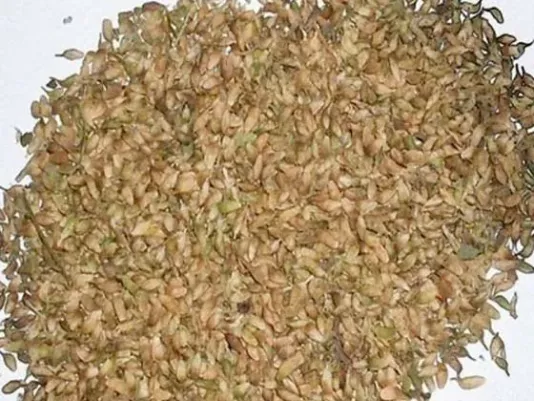Flatbread with Meat
Flatbread with meat (kubdari) – recipe for cooking Georgian cuisine, the cake is flatbread in the oven.

Utskho-Suneli is a spice without which I can’t imagine a harmonious sauce or braised meat. It’s made from dried blue fenugreek beans ground into a fine powder. Over years of cooking, I’ve realized its strength lies not in sharpness but in delicacy. Utskho-Suneli has a dry, slightly bitter aroma with notes of walnut and hay that become warmer and softer after heating. I use it when I want to give a dish a rounded flavor without excessive saltiness or acidity. In soups, it reveals itself gradually, while in sauces – immediately after heating the oil. This spice should be stored tightly sealed, as its aroma fades quickly. If it loses its scent, it’s best replaced, since a fresh blend is recognizable even by color.
Over years of buying spices, I’ve learned to assess the quality of Utskho-Suneli literally by its smell and color. A fresh seasoning has a warm grayish-green shade, free of lumps or foreign particles. If the color is too bright or the scent sharply resembles mustard, it means cheap substitutes have been added. It’s best to buy it by weight in trusted shops where spices are stored in airtight containers away from sunlight. When opening the package, the aroma should be rich but not harsh – that’s how I know the fenugreek beans were properly dried. When over-dried, the spice smells dusty and lacks that characteristic nutty warmth in dishes. In my experience, it’s important not only to buy a quality product but also to store it properly: in a glass jar, in a dark place, away from moisture. If condensation appears on the jar walls, the spice will lose its aroma within days, so I always buy small portions and refresh my supply every few months.
Before adding Utskho-Suneli to a dish, I always check its condition. Even high-quality spice weakens over time, so before using, I quickly warm it on a dry pan for a few seconds over low heat. This awakens the essential oils and deepens the aroma. It’s important not to overheat it, or the bitterness will dominate. Sometimes I add a pinch of Utskho-Suneli to warm butter or cream – this helps it dissolve more evenly. For marinades and sauces, I often mix it with a little warm water to prevent it from settling at the bottom. If a dish will be stewed for a long time, the spice can be added at the beginning, but for sauces or soups, I add it closer to the end to preserve the aroma. From my experience, the key is not to exceed the dose: for a 4-serving dish, half a teaspoon is enough; otherwise, the flavors become flat, and the bitterness overpowers the natural sweetness of the vegetables.
During heat treatment, Utskho-Suneli behaves differently depending on temperature. If heated over high flame, its essential oils quickly evaporate, leaving only bitterness. That’s why I always add the spice when the dish has already been removed from vigorous boiling or when the meat transitions from frying to stewing. That’s when the aroma opens up most fully without losing its delicate notes. In thick sauces, the spice helps create a denser texture by partially binding the liquid, adding a sense of depth. When used with coriander or garlic, the aroma becomes rounder and more persistent. I’ve also noticed that Utskho-Suneli works well in dishes with cream or tomatoes but doesn’t tolerate too much acidity – the flavor becomes coarse. When served at a lower temperature, the spice tastes milder, so for salad dressings, I use only a small amount, pre-ground with salt.
In my kitchen, Utskho-Suneli rarely stands alone – it loves company. It pairs best with coriander, dried basil, turmeric, savory, and a bit of hot pepper. This creates a balanced aromatic profile without excessive bitterness. I often make my own meat blend: Utskho-Suneli, dried garlic, a touch of sweet paprika, and a pinch of black pepper. In this combination, the spice unfolds more deeply, adding a gentle nutty undertone. When used with bay leaf or cumin, the amount should be reduced – they compete for dominance in aroma. With herbs like oregano or parsley, Utskho-Suneli creates a softer balance, enhancing the natural saltiness of ingredients. Through years of experimentation, I’ve found that the best effect comes from adding the spice to a fatty base – butter or oil – which locks in the aroma. This method ensures a lasting flavor even after the dish cools.
The most common mistake I see is using too much Utskho-Suneli or adding it at the wrong time. If added to a boiling dish, it will lose its aroma and leave only bitterness. Another mistake is using an old blend. A few months after opening, its scent fades, so I store small portions. It’s also best not to mix Utskho-Suneli with overly smoky or aromatic spices – they mute its natural nutty note. To avoid excess bitterness, don’t over-fry it in fat: just a few seconds are enough to release the fragrance. I always monitor the aroma while cooking – if it becomes too sharp, I add a bit of acidity (tomato or lemon juice) to soften the flavor. In my practice, the best results come when the spice plays a supporting role, enhancing the main ingredient rather than overpowering it. Such restraint is what distinguishes good Utskho-Suneli from an ordinary seasoning.